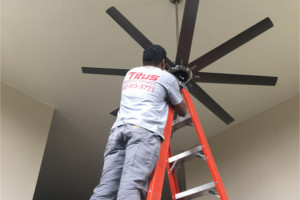Beat the Heat, Not Your Budget: Unveiling the Energy Efficiency of Ceiling Fans in Fort Collins Homes

Introduction:
Ceiling fans are a common fixture in many homes, providing a cool breeze and helping to circulate air. However, there is often a question surrounding their energy efficiency. Do ceiling fans waste energy? In this blog post, we will delve into the energy consumption of ceiling fans, their effectiveness in keeping rooms cool, the cost involved in running them, and ultimately determine whether they are an energy-efficient choice for your home. Whether you're considering ceiling fan installation, need assistance with installing a ceiling fan, or are looking for an electrician in Fort Collins, this guide will provide you with valuable insights.
How Much Energy Do Ceiling Fans Consume?
Compared to air conditioning units, ceiling fans consume significantly less energy. On average, a ceiling fan consumes between 10 to 120 watts of electricity, depending on its size and speed setting. For comparison, a typical air conditioner can consume anywhere from 500 to 3500 watts per hour. Ceiling fans are designed to be energy-efficient, allowing you to enjoy a cooling effect while using less electricity. By using ceiling fans instead of relying solely on air conditioning, you can potentially reduce your energy consumption and lower your utility bills.
Do Ceiling Fans Keep Rooms Cool?
Ceiling fans do not actually lower the temperature in a room. Instead, they create a wind chill effect, which makes you feel cooler by increasing the evaporation of moisture from your skin. This sensation can provide relief during hot weather and help maintain a comfortable environment. It's important to note that ceiling fans cool people, not rooms. Therefore, it's recommended to turn off ceiling fans when no one is in the room to maximize energy efficiency.
Cost Involved to Run a Ceiling Fan:
The cost of running a ceiling fan depends on several factors, including the wattage of the fan, the electricity rate in your area, and the duration of usage. To calculate the cost, you can multiply the wattage of the fan by the number of hours it is used and divide it by 1000 to convert to kilowatt-hours. Then, multiply the result by your electricity rate per kilowatt-hour. The overall cost to run a ceiling fan is relatively low compared to other cooling options. However, it's important to note that leaving the fan on in unoccupied rooms can lead to unnecessary energy waste and increased costs.
Conclusion:
In conclusion, while ceiling fans do consume electricity, they are generally considered energy-efficient compared to other cooling options. They provide a cooling effect by creating a wind chill effect that makes you feel cooler, without actually lowering the room temperature. Ceiling fans can be a cost-effective alternative to air conditioning, helping to reduce your energy consumption and utility bills.
When it comes to ceiling fan installation or assistance with installing a ceiling fan, it's advisable to seek the expertise of a local professional Fort Collins electrician. They can ensure that the installation is done safely, the wiring is properly connected, and the fan is securely mounted. Additionally, an electrician can provide guidance on choosing the right fan for your needs, considering factors such as size, energy efficiency ratings, and overall performance.
If you're looking to improve the comfort and airflow in your home while minimizing energy consumption, installing a ceiling fan can be a great option. By using ceiling fans strategically and adopting energy-saving habits, such as turning off fans in unoccupied rooms, you can enjoy the benefits of a cool breeze without wasting energy.
